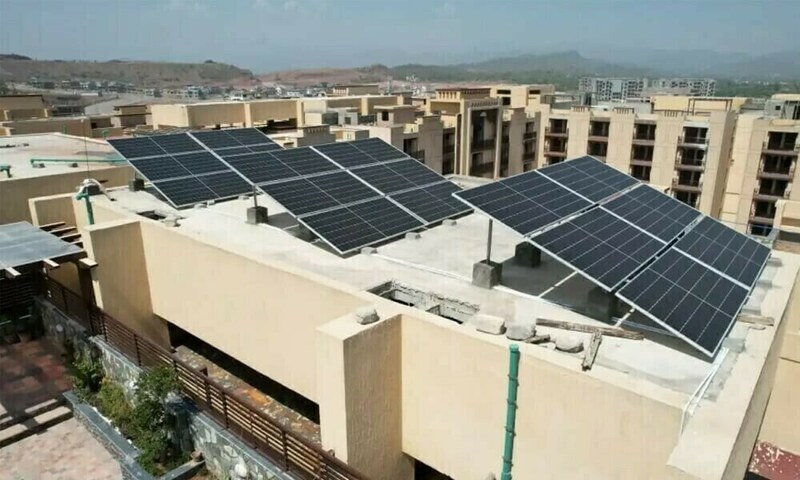By Omer Rizwan
Copyright brecorder

As electricity prices rise, more consumers are moving towards rooftop solar to reduce their electricity bills, which has resulted in an increase of net metering connections.
While the surge in net-metering connections empowers consumers, it poses a new challenge to Pakistan’s traditional electricity distribution network, which was designed to deliver electricity in one direction- from the grid to the user.
The current tariff package for net-metering offers an attractive payback period of 2-4 years for 5-25 kilowatt (kW) solar PV installations. The simple economics has resulted in entire neighbourhoods shifting towards rooftop solar. What this means for the utility is that individuals that were simple consumers have now become “prosumers”, i.e., individuals that produce and consume electricity.
The issue starts when the “prosumers” start producing more electricity and stop consuming electricity from the grid. The traditional electricity grid has a uni-directional power flow; electricity is produced by the power plants transported via the transmission network, gets connected to the local grid and then flows through the distribution network to reach the end consumers.
When prosumers start producing more electricity it results in a “reverse power flow”. Unlike household appliances that can simply be switched off when not needed, the national grid has no off switch. When prosumers stop consuming and begin exporting excess solar energy, the grid must absorb it, whether it’s needed or not.
The reverse power flow from solar PV exports lies in the third quadrant of the transformer quadrant loading model, where both active and reactive power flow in the grid. This results in over-excitation of the transformer core resulting in core saturation. This can result in increased core losses, thermal stress and accelerate insulation aging, thereby significantly reducing the life of a distribution transformer.
The over-excitation can also result in voltage swings and production of harmonics, which can significantly impact the power quality of the network. To address the voltage fluctuations, utilities like “K-Electric” may change the tap position on the transformer to stabilize the voltage.
However, if solar output changes, the voltage levels would change again thereby requiring the tap position to be changed again. The frequent change in transformer tapping accelerates the mechanical risk, resulting in an increase in maintenance costs and failure risks.
Utilities require a multi-pronged strategy, one that goes beyond manual tap changes, to rectify the negative impact of reverse power flow. Utilities should ensure consumers install smart inverters with autonomous “Volt-Var” Control, a function that adjusts the reactive power output of the inverter based on local voltage conditions.
While this feature may not stop reverse power flow, it helps stabilize voltage and reduces stress on transformers and other equipment. Utilities, in parallel, should also ensure that the inverters installed are compliant with IEEE 1547-2018, which ensures that inverters have special functionalities that can help with grid stability.
IEEE 1547-2018 is an internationally recognised standard for interconnecting distributed energy resources (DERs) like rooftop solar panels, battery storage, wind systems, etc., with the electric power grid.
Similarly, AEDB certified installers should demonstrate competency that they have proper understanding of these features and can calibrate the inverter accordingly. For a long-term grid resilience strategy, utilities should plan for the integration of distributed energy resources with Advanced Distribution Management System (ADMS).
Another option that utilities should also consider is the installation of local Battery Energy Storage Systems (BESS) on the Low-Tension side of the distribution transformers. Batteries can absorb excess energy produced from solar generation during daytime and supply it back to the consumers during night hours.
Installation of BESS on the low-tension side can significantly reduce reverse power flow (if proper sizing is done) and can save the utility from expensive network upgrades. Utilities in Australia are already piloting “Pole mounted Batteries” to increase network reliability and optimize existing grid capacity without upgrading the network.
Some utilities in Australia also impose a penalty on the prosumers called the “sun tax” when they export electricity into the grid during peak solar generation hours. This policy was put in place to reduce stress on the network.
In 2015, the Hawaii Public Utilities Commission issued a ruling to end net metering for all new solar customers in the state. This decision was driven by Hawaii Electric Co.’s (HECO’s) concerns about grid reliability due to an increase in transient overvoltage and reverse power flow events. As a result, HECO transitioned to alternate programmes that offer controlled and limited export options compared to net metering.
In 2023, California adopted a new net billing tariff, commonly known as NEM 3.0, to more accurately reflect the value of electricity exported to the grid by the prosumers. This means that instead of paying full retail price, the utilities will now pay the prosumers an amount based on the actual “worth” of electricity during the time of export
Rooftop solar is here to stay in Pakistan; it is now up to the utilities and regulatory body to shift the equation in their favour. Network damages due to reverse power flow are no longer theoretical risks but have become an operational reality. Utilities need to adopt dynamic and smarter approaches beyond the tariff models.
Such measures will not only protect the electricity infrastructure but will also ensure that the growth of solar remains sustainable.
Copyright Business Recorder, 2025



